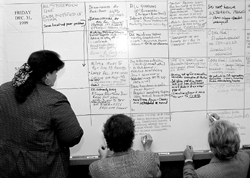The University Record, December 13, 1999 By Jane R. Elgass

University staff who will be on the front lines as we enter the next century at the end of the month participated in a three-hour session Dec. 7 to test the processes and lines of communication that have been developed to handle problems.
The mock exercise, developed by James C. Snyder, associate dean and professor of architecture and urban planning, and graduate students Charlie Kaylor and Moira Zellner, had staff dealing with such challenges as a power outage on North Campus, scattered losses of water, demonstrations by animal rights activists and loss of Ameritech (outside) telephone lines, all against a weather backdrop featuring an ice storm and temperature of 5 degrees. And, oh yes, there was an 80-vehicle accident at US-23 and I-94 that overwhelmed the emergency room at University Hospital.
The simulated incidents started shortly after midnight Dec. 31, and continued for about 18 hours of mock time.
Key personnel who will form the emergency operatons center (EOC) during the Y2K rollover period were stationed at a U-shaped table, facing a status board and mock television monitors in a conference room at the Campus Safety Services Building on Kipke Drive.

They were supported by a number of “tier one” responders who will be responsible for implementing contingency plans should any out-of-the-ordinary incident occur. Also present at the mock exercise were “tier two” personnel, who during the rollover will be stationed either at their campus offices or at home and on call.
University officials are confident that all U-M systems are “go” for a smooth transition, but can’t rule out external problems that would affect operations, such as bad weather or power outages. The mock exercise gave everyone a chance to test their mettle and spot weaknesses in plans for dealing with problems.
“You plan for the worst,” Snyder told participants. “If you can handle the worst case, you can handle the simpler ones.”
Preparing participants for the exercise, he reminded them of the steps they would need to take when faced with a problem: assess the importance of the event and assess the possible consequences, make decisions and possibly take action, and, above all, communicate clearly using the five Ws—who, what, where, why, when.
In addition to the status board, which will be updated on a continuous basis, the EOC members will maintain log sheets of incidents reported, decisions made and actions taken. These will be available for later review, so the University can refine emergency procedures where necessary.
The exercise, as intended, did uncover a few minor glitches, all of which are being addressed. The status board, which spans a 30-foot wall, didn’t have enough space for entries, so good old-fashioned flip charts likely will be used. The television sets weren’t easily viewable by those charged with monitoring the BBC, Weather Channel and other stations. They’ll be clustered near the information team’s table.
One participant realized he would not be able to reach his staff to ask them to come in if Ameritech lines are down. He’ll be telling them to stay tuned to the radio stations the University has identified that will be asked to carry special announcements if problems are encountered on campus.

